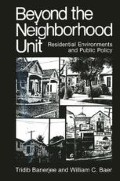Abstract
At the outset of our study, we suspected that the neighborhood unit model might have outlived its purpose, despite its persistence as a paradigm. This skepticism was reinforced by strong and forceful arguments made by various scholars and practitioners, which we reviewed in Chapter 2. Indeed, we have found little in our own research to deny this skepticism, much less to refute the critics of the model. True, some of our findings lend credence to certain facility location standards linked to the neighborhood unit concept, but that credence is not sufficient to warrant a wholesale endorsement of the model. Nor for that matter does the fact that the ideal of the neighborhood is still highly valued by the majority of the respondents mean total vindication of the neighborhood unit concept. All it suggests is that some of the contextual values still have a following, even though the manifest functions of residential environments have become diversified, as shown by our findings and those of others in recent years.
Access this chapter
Tax calculation will be finalised at checkout
Purchases are for personal use only
Preview
Unable to display preview. Download preview PDF.
Notes
The fact that we did not elicit any one construct, or even a dominant construct of residential area from our respondents, suggests at least three possibilities. First, this outcome simply may be an artifact of our methodology (e.g., our research assumptions, sampling plan, or interview protocol), and not a function of the phenomenon itself. But other studies using more narrowly defined research variables (cf. Lee, 1968), and based on different methodologies and nationally drawn samples (Coleman, 1978; U.S. Department of Housing and Urban Development, n.d.), have also found a wide range of perceptions and constructs of the residential environment, many of which are similar to ours. A second possibility is that our findings were influenced by the environment in which our study was conducted (i.e., Los Angeles). The variability in responses may simply reflect the wide variations in the physical character of residential locations in the Los Angeles metropolitan area. An alternative explanation in this vein would suggest that the formless, characterless sea of undifferentiated sprawl in Los Angeles precludes the formation of a dominant construct, or that the high degree of intracity residential mobility—which is typical of Los Angeles residents— contributes to these “multiple visions” of residential environments. All of these explanations seem plausible, but we suggest that Los Angeles is typical of most metropolitan development in the West and the Southwest and of much of the newer suburban development in the South and the East, and so this “bias” is certainly not irrelevant. We think the most likely explanation is that personal constructs of the residential environment are likely to be highly variable because of differences in individual values, tastes, lifestyles, personality traits, and the like, and that this is why we have seen so many different versions of what the residential area means to people and what matters most to them in this environment.
Alexander et al. (1977) have further developed this concept, proposing specific criteria for physical design.
We hasten to add, in all fairness to the design profession, that the tendency to impose order and organization in the face of complexity is not unique to designers; others are known to succumb to this human frailty. It will be recalled that sociologist Suttles’s (1975) schema for a community design framework also showed a neat hierarchical organization.
See, for example, “Richard Sennett Lectures on Democratic Theory and Urban Form” (1982).
But empirical research into citizens’ perceptions of differences in neighborhood services shows rough equality (the respondents were asked to rate their neighborhood services with those of other neighborhoods), although many researchers doubt the validity of such perceptions as a surrogate for obejctive measures (Rich, 1979). There are other reasons to question these findings: neighborhood pride, variable expectation levels, variable thresholds of satisfaction (Campbell et al., 1976), limited knowledge about the technical aspects of public-service delivery systems, and the like can all distort such perceptions. In any event, these findings need not be seen as contradictory to ours, because we did not query our respondents about specific neighborhood services or other comparative qualities. We were more interested in the global perceptions and evaluations of the residents’ current environments.
Public choice scholars would, of course, argue that equality of outcomes is extremely difficult and costly to measure, and that therefore such a goal is not particularly viable (see Rich, 1979).
That the poor have lower levels of expectation—and therefore of satisfaction—has been shown by Campbell et al. (1976). It has been evident in other parts of our study—especially in relation to attribute satisfaction and trade-off preferences. The implication is that bringing the environmental qualities of poor areas up to the residents’ expectations may still fall far short of any objective equality outcome, as measured by the incidence of crime or by the level of air pollutants.
Schulze (1980) interpreted Rawls’s argument, that social welfare is improved when the welfare of the worst off improves, as essentially an expression of egalitarian ethics.
We are omitting the notion of “market equity,” which, even according to the public choice theorists, would amount to an exacerbation of existing inequalities (Rich, 1979).
Author information
Authors and Affiliations
Rights and permissions
Copyright information
© 1984 Springer Science+Business Media New York
About this chapter
Cite this chapter
Banerjee, T., Baer, W.C. (1984). Toward a New Design Paradigm. In: Beyond the Neighborhood Unit. Environment, Development, and Public Policy: Environmental Policy and Planning. Springer, Boston, MA. https://doi.org/10.1007/978-1-4757-9418-2_7
Download citation
DOI: https://doi.org/10.1007/978-1-4757-9418-2_7
Publisher Name: Springer, Boston, MA
Print ISBN: 978-1-4757-9420-5
Online ISBN: 978-1-4757-9418-2
eBook Packages: Springer Book Archive

